As I wrote game design documentation for my game.
In 2015-2016 I set myself the task of developing game design documentation for my game that I would like to someday do. Under the cut you will find a brief description of what I managed.
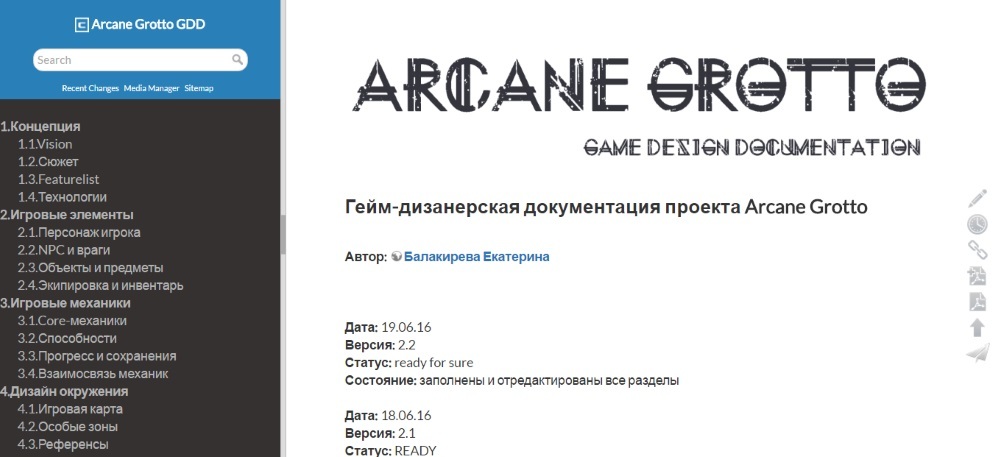
')
Despite the fact that game development is a creative process, it requires constant fixation of key ideas, the opportunity at any time to provide team members with access to them, and effective organization of the work of the entire project team. For my project it was important to put together all the basic information about the game, structured in sections in which you can easily navigate.
Therefore, my tasks were as follows:
While working on the project, for familiarization I used examples of real game documentation, available on the net, document templates I have, as well as articles on the topics covered. For example, there are some good materials on gamasutra.com , tutsplus.com , gamedev.net .
For a brief description of the game, it is enough to make a Vision-document - about what it is and how it is done there is an article in Habré: here it is . In the course of the preparation of the project of ideas, it became more and more, and it was necessary to explain the key features and give a more detailed idea of the mechanics of the game, so I stopped at the following structure of my design document, which in essence was the whole project.
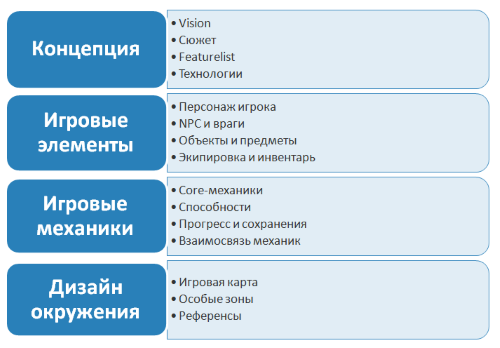
Contains Vision, description of the plot of the game, a list of features and technological solutions. It can be said that the main purpose of this section is to give a general idea of the project, to answer supposed questions about the project “in two words”. For example, in the section about the plot, the plot is described and a small glossary is required to explain the terms, concepts and names that are used later. Featurelist contains key features of the game, including those that distinguish the project from other similar ones. The technology section describes how the game is developed, which software is used for graphics, audio, etc.
Game elements are all that the player has to interact with in one way or another in the game. The player’s character (or several characters in the case of a multiplayer game mode), non-player characters, enemies, as well as the definition and list of objects and objects are all described in general terms and for convenience divided into groups and categories (for example, for which items applies where it occurs, what are the possible types of interaction with the subject, etc.).
This section is very elaborate, because it contains a lot of information about how the game should work, what game mechanics will be used, describes the player's progress system in the game, and how the mechanics are interconnected.
It is always interesting to understand how the game works, what is affected by certain parameters. But here the novice game designer may face a number of difficulties. It is very important to be able to or at least try to explain things in simple language and avoid unnecessary clarifications that can confuse a person unprepared for a large amount of game information.
For example, when creating classes and abilities of characters, I was guided by the classical archetypes of characters in role-playing games, which were embodied in the classes Defender, Druid, and Shadow.

Not being an artist, it is quite problematic to depict fantastic landscapes, and indeed any other images that are drawn in your head. Therefore, in this section it was appropriate to show what the game locations will look like, describe the individual game zones and the map as a whole.
Here, for example, is a small collage of artworks from my beloved deviantart.com , which I picked up as references:
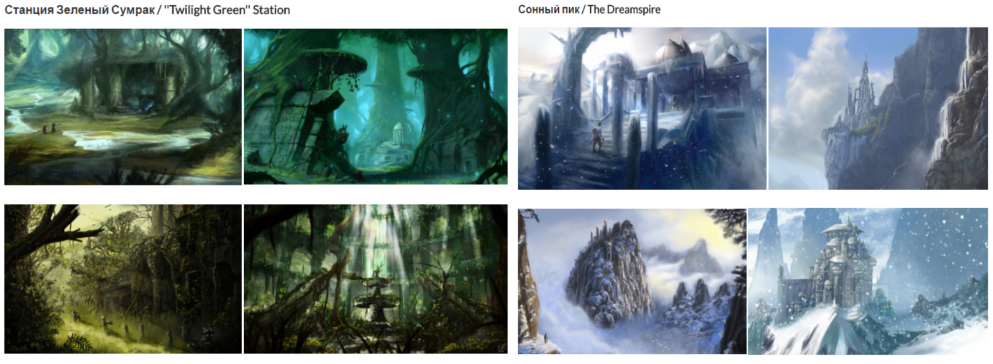
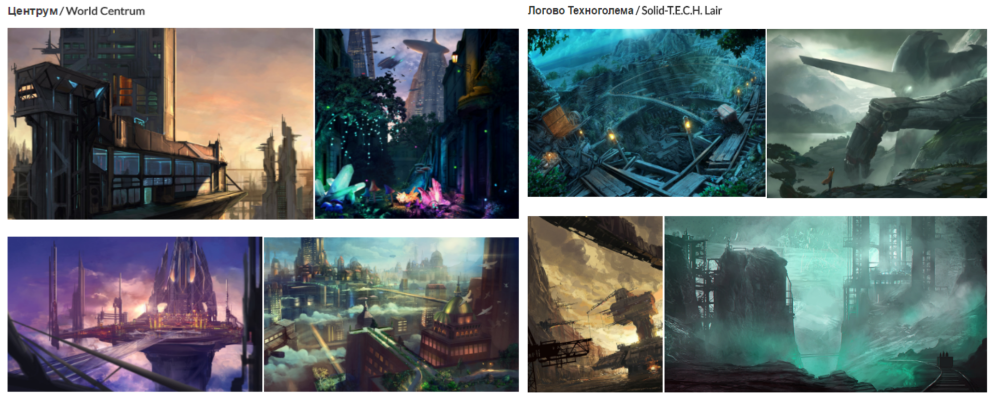
It turned out to be quite time-consuming to carry out the analysis, because there is not so much relevant information at the moment in open access to the network. Nevertheless, it is useful to know that now in a trend, in what condition the interesting segment of the game market is. The main issues that interested me in the project were the following:
These and other questions had to be answered using analytics available on the Internet (for example, reports from Newzoo, Superdata, Mail.ru Group and others). By the way, quite a lot of references to game analytics from different companies are in a separate article on Habré .
The gameplay of my game project relies heavily on the cooperative passage of two players. Therefore, the game market research was conducted for the PC and console game segment, with multiplayer mode for two to four people. Were analyzed user reviews of games in Steam, ratings on metacritic, articles of popular game portals, such as pcgamer.com .
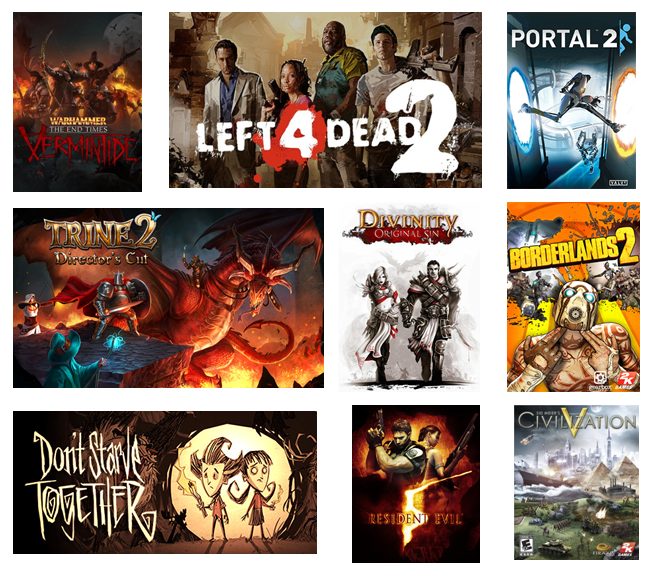
As a result of a comprehensive analysis, it was possible to determine the advantages of this particular project and whether it will be attractive enough for the target audience. It is also useful to outline the “development paths” - obviously, for a game with a single or cooperative mode, which left good impressions behind you, creating a series of games in a single universe can be a worthy goal and a project for further development.
Summing up the work done, I would like to say about some of the difficulties that confronted me in the process of preparing the project. Obviously, the documentation helps to decompose the game into components and introduces at least some order into the ideological chaos. However, in fact, it is not easy to link these components together. For example, you need to constantly ensure that the abilities of heroes and individual mechanics fit into the atmosphere of the game. Coming up with game activities, you should often ask yourself the question - why would the player do all this, are there any logical or plot-based reasons for the events, would the alleged activity move the player to progress and make him achieve more?
Ponapriduvat abilities, try to "pack" them into the interface and estimate how such a system will be convenient and understandable. Do not forget that not only dialogues and cutscenes are able to tell stories and convey some message to the player. Puzzled by the economics of the game, the balance of classes or strategies. It seems that the problems that need to be solved by the game designer are infinitely many. A playable prototype will help to cope with many of them (the development of which should not be put on the back burner, because usually at this stage it becomes clear whether it is worth developing at all) and, of course, playtests. But this does not mean that all sorts of problems and the possibilities of their solution should not be thought of already at the concept stage.
If you have questions on the topic - ask, I will answer in the comments.

')
We define objectives and goals
Despite the fact that game development is a creative process, it requires constant fixation of key ideas, the opportunity at any time to provide team members with access to them, and effective organization of the work of the entire project team. For my project it was important to put together all the basic information about the game, structured in sections in which you can easily navigate.
Therefore, my tasks were as follows:
- Create a game project concept, namely to turn an abstract idea into a readable and understandable detailed description;
- To structure and formalize this concept (in my case at DokuWiki);
- To analyze the game intended for development and the factors influencing the development of the market, the audience, similar games;
- Make a conclusion on the results of their work and prepare a presentation of the resulting project.
While working on the project, for familiarization I used examples of real game documentation, available on the net, document templates I have, as well as articles on the topics covered. For example, there are some good materials on gamasutra.com , tutsplus.com , gamedev.net .
We concept
For a brief description of the game, it is enough to make a Vision-document - about what it is and how it is done there is an article in Habré: here it is . In the course of the preparation of the project of ideas, it became more and more, and it was necessary to explain the key features and give a more detailed idea of the mechanics of the game, so I stopped at the following structure of my design document, which in essence was the whole project.

Game project concept
Contains Vision, description of the plot of the game, a list of features and technological solutions. It can be said that the main purpose of this section is to give a general idea of the project, to answer supposed questions about the project “in two words”. For example, in the section about the plot, the plot is described and a small glossary is required to explain the terms, concepts and names that are used later. Featurelist contains key features of the game, including those that distinguish the project from other similar ones. The technology section describes how the game is developed, which software is used for graphics, audio, etc.
Game elements
Game elements are all that the player has to interact with in one way or another in the game. The player’s character (or several characters in the case of a multiplayer game mode), non-player characters, enemies, as well as the definition and list of objects and objects are all described in general terms and for convenience divided into groups and categories (for example, for which items applies where it occurs, what are the possible types of interaction with the subject, etc.).
Game mechanics
This section is very elaborate, because it contains a lot of information about how the game should work, what game mechanics will be used, describes the player's progress system in the game, and how the mechanics are interconnected.
It is always interesting to understand how the game works, what is affected by certain parameters. But here the novice game designer may face a number of difficulties. It is very important to be able to or at least try to explain things in simple language and avoid unnecessary clarifications that can confuse a person unprepared for a large amount of game information.
For example, when creating classes and abilities of characters, I was guided by the classical archetypes of characters in role-playing games, which were embodied in the classes Defender, Druid, and Shadow.

Environment design
Not being an artist, it is quite problematic to depict fantastic landscapes, and indeed any other images that are drawn in your head. Therefore, in this section it was appropriate to show what the game locations will look like, describe the individual game zones and the map as a whole.
Here, for example, is a small collage of artworks from my beloved deviantart.com , which I picked up as references:


We carry out the analysis
It turned out to be quite time-consuming to carry out the analysis, because there is not so much relevant information at the moment in open access to the network. Nevertheless, it is useful to know that now in a trend, in what condition the interesting segment of the game market is. The main issues that interested me in the project were the following:
- What genres of PC games have been popular in recent years?
- What are the trends in the global gaming market?
- How popular are the mechanics and game modes presented in my project, and for what audience can this game be of the most interest?
These and other questions had to be answered using analytics available on the Internet (for example, reports from Newzoo, Superdata, Mail.ru Group and others). By the way, quite a lot of references to game analytics from different companies are in a separate article on Habré .
The gameplay of my game project relies heavily on the cooperative passage of two players. Therefore, the game market research was conducted for the PC and console game segment, with multiplayer mode for two to four people. Were analyzed user reviews of games in Steam, ratings on metacritic, articles of popular game portals, such as pcgamer.com .

As a result of a comprehensive analysis, it was possible to determine the advantages of this particular project and whether it will be attractive enough for the target audience. It is also useful to outline the “development paths” - obviously, for a game with a single or cooperative mode, which left good impressions behind you, creating a series of games in a single universe can be a worthy goal and a project for further development.
Conclusions and materials
Summing up the work done, I would like to say about some of the difficulties that confronted me in the process of preparing the project. Obviously, the documentation helps to decompose the game into components and introduces at least some order into the ideological chaos. However, in fact, it is not easy to link these components together. For example, you need to constantly ensure that the abilities of heroes and individual mechanics fit into the atmosphere of the game. Coming up with game activities, you should often ask yourself the question - why would the player do all this, are there any logical or plot-based reasons for the events, would the alleged activity move the player to progress and make him achieve more?
Ponapriduvat abilities, try to "pack" them into the interface and estimate how such a system will be convenient and understandable. Do not forget that not only dialogues and cutscenes are able to tell stories and convey some message to the player. Puzzled by the economics of the game, the balance of classes or strategies. It seems that the problems that need to be solved by the game designer are infinitely many. A playable prototype will help to cope with many of them (the development of which should not be put on the back burner, because usually at this stage it becomes clear whether it is worth developing at all) and, of course, playtests. But this does not mean that all sorts of problems and the possibilities of their solution should not be thought of already at the concept stage.
If you have questions on the topic - ask, I will answer in the comments.
Source: https://habr.com/ru/post/306876/
All Articles